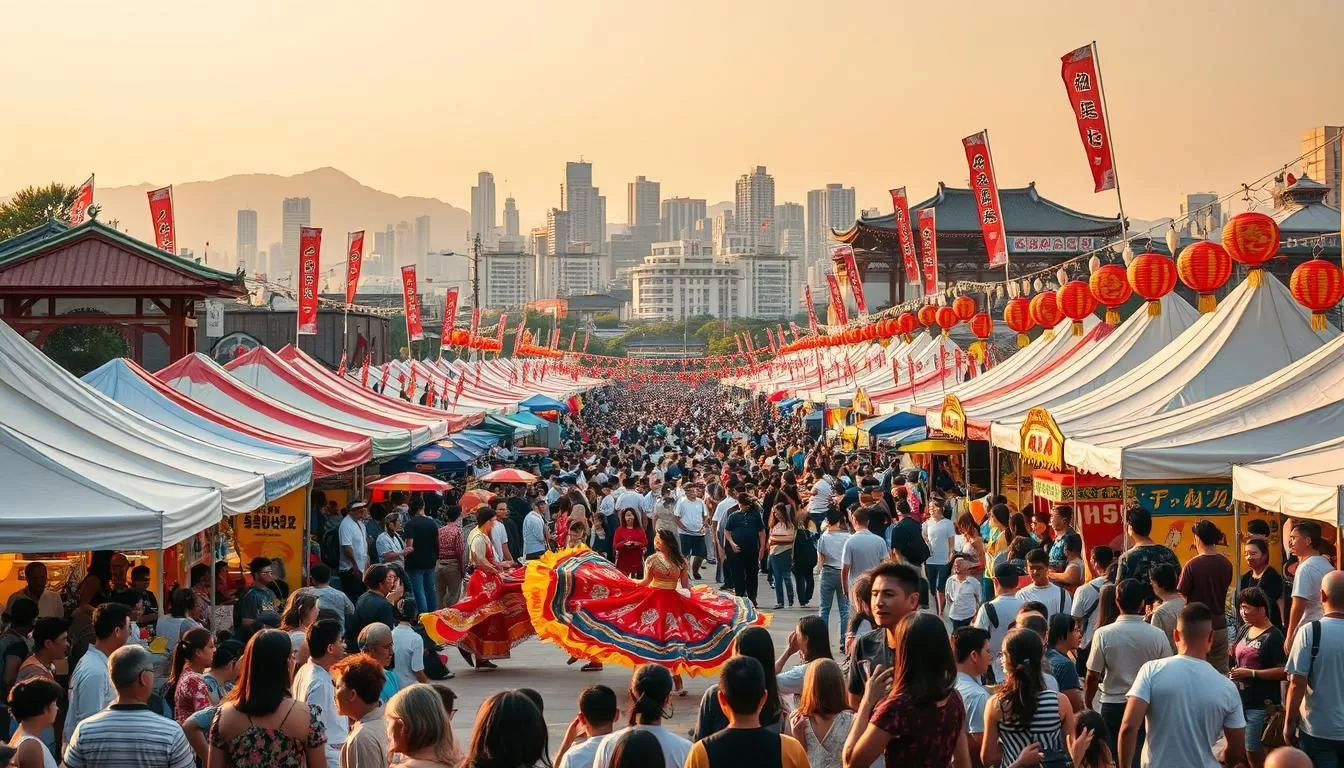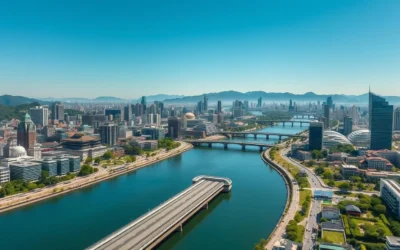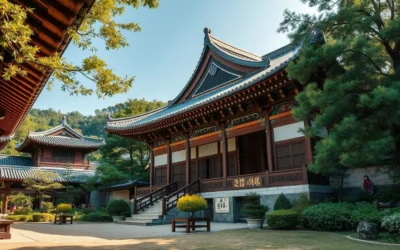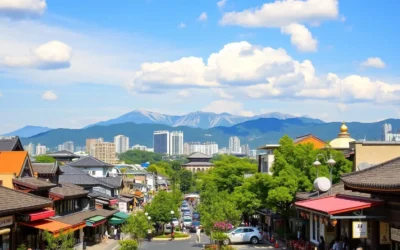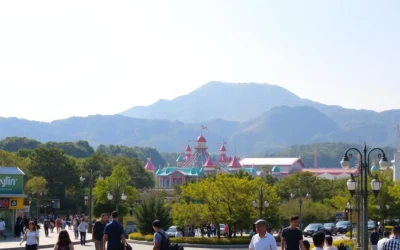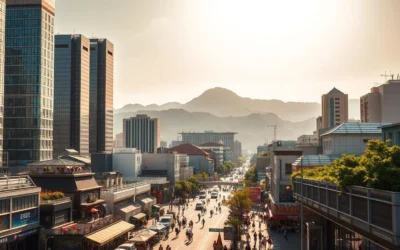✓ Accommodations✓ Flights✓ Rental Cars✓ Tours & Activities ✓ Tours & Activities
Imagine stepping into a world where ancient traditions meet modern creativity. This is what you’ll find in the heart of a country known for its rich cultural heritage. From lantern parades to contemporary art displays, every event tells a story that connects the past with the present.
These celebrations are more than just events; they are immersive experiences. You’ll feel the energy of the crowd, see the vibrant colors, and hear the sounds of traditional music. It’s a chance to dive deep into a culture that values both its history and its future.
With over 100 festivals held annually, there’s always something to explore. Whether it’s the Cherry Blossom Festival in spring or the Lantern Festival in fall, each event offers a unique glimpse into this dynamic culture. You’ll leave with memories that last a lifetime.
Discover the Vibrant Festival Scene in South Korea
Experience the magic of cultural celebrations that blend history and innovation. These events are more than just gatherings; they are windows into a rich heritage that continues to evolve. From traditional harvest festivals to modern art displays, each event offers a unique glimpse into the heart of this dynamic culture.
Why Festivals are a Must-See
Festivals are essential experiences that connect you to the soul of a place. They showcase the importance of family, community, and tradition. For example, Chuseok, often compared to Thanksgiving, is a time for family reunions and feasting, highlighting the significance of harvest in the local culture.
These events also reflect the historical and cultural evolution of the region. The Andong Mask Dance Festival, recognized by UNESCO, features performances that date back to the 12th century, offering both education and entertainment.
Cultural Highlights and Unique Traditions
Each festival is a celebration of unique traditions. The Jinhae Gunhangje Festival, held in early April, attracts thousands with its stunning cherry blossom displays and parades. Meanwhile, the Busan Sea Festival brings summer to life with beach activities, concerts, and fireworks.
Modern festivals also play a key role in showcasing artistic expressions. The Incheon Pentaport Rock Festival features both local and international artists, contributing to the vibrant music scene.
Whether you’re exploring traditional games or enjoying interactive workshops, these events offer unforgettable experiences that celebrate the past and present.
Seoul, South Korea: Top Festivals to Check Out When Visiting
Every year, the city transforms into a hub of cultural celebration. From lantern-lit rivers to bustling streets, each place becomes a stage for creativity and tradition. These events are not just about entertainment; they’re a window into the heart of a dynamic culture.
One of the most iconic events is the Seoul Lantern Festival. Held from mid-December to late January, it features thousands of intricately designed lanterns along the Cheonggyecheon Stream. The festival illuminates the city, blending art and history in a mesmerizing display.
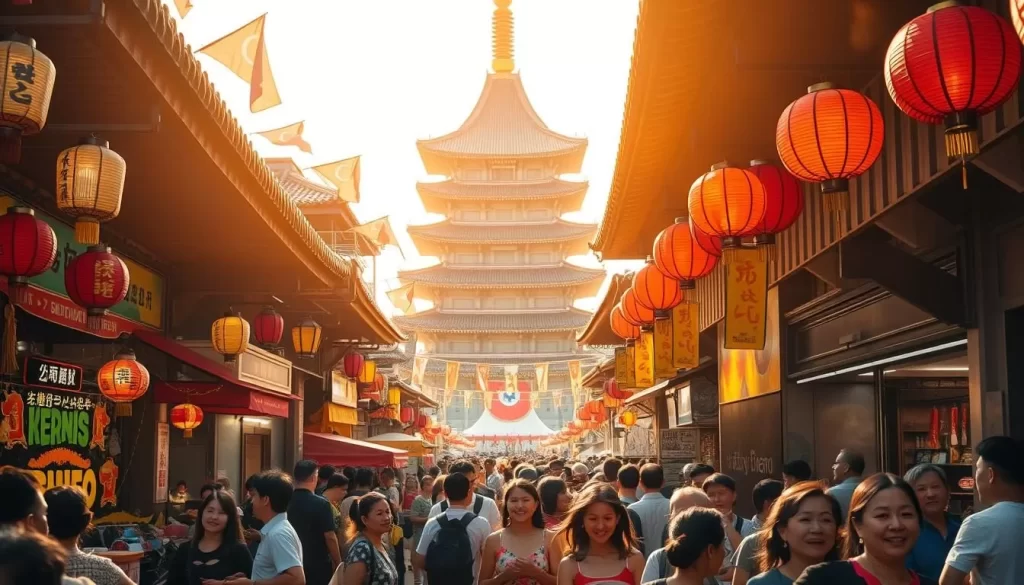
For those who love music, the Seoul International Fireworks Festival is a must-see. Recognized as the country’s number one festival, it lights up the sky in early October with stunning pyrotechnics and live performances. It’s a perfect blend of visual and auditory artistry.
Another highlight is the Seokchon Lake Cherry Blossom Festival. Celebrated in late March, it showcases over 1,000 cherry blossom trees, creating a picturesque setting for visitors. The event is a testament to the city’s ability to merge natural beauty with cultural celebration.
These festivals are more than just events; they’re immersive experiences. They educate visitors about the rich history and traditions of the region. Whether it’s through traditional performances or modern art displays, each celebration leaves a lasting impression.
| Festival | Time of Year | Highlights |
|---|---|---|
| Seoul Lantern Festival | Mid-December to late January | Thousands of lanterns along Cheonggyecheon Stream |
| Seoul International Fireworks Festival | Early October | Pyrotechnics and live music performances |
| Seokchon Lake Cherry Blossom Festival | Late March | Over 1,000 cherry blossom trees |
From the vibrant colors of lanterns to the melodies of live music, these festivals offer something for everyone. They transform the city into a place where culture, history, and creativity come together. Don’t miss the chance to experience these unforgettable events.
Seasonal Celebrations in the Heart of Seoul
As the seasons change, the city comes alive with vibrant celebrations that honor nature and tradition. Each season brings its own unique charm, offering visitors a chance to experience the city’s rich cultural heritage in different ways. From the delicate beauty of cherry blossoms in spring to the frosty magic of winter ice festivals, these events are a testament to the city’s ability to blend natural beauty with cultural significance.
Spring Events and Cherry Blossom Festivals
Spring is a time of renewal, and the city celebrates this season with breathtaking cherry blossom festivals. The Jinhae Gunhangje Festival is one of the most popular, attracting thousands of visitors with its vibrant pink and white trees and scenic walks. Over 1.5 million attendees were reported in 2023, making it a must-see event.
These festivals are more than just a visual treat; they are a cultural experience. Visitors can enjoy parades, traditional performances, and even participate in workshops that highlight the importance of nature in the local culture. The city’s parks and streets transform into a sea of blossoms, creating a picturesque setting that’s perfect for photography and relaxation.
Winter Wonders and Ice Festival Experiences
Winter in the city is equally enchanting, with ice festivals that turn the frosty landscape into a playground of fun. The Hwacheon Sancheoneo Ice Festival is a highlight, offering activities like ice fishing and sledding. This event attracts around 300,000 visitors annually, making it one of the most popular winter celebrations.
Another standout is the Taebaek Snow Festival, which features over 100 snow sculptures and engages more than 150,000 participants each year. These festivals showcase the city’s ability to embrace the cold and create unforgettable experiences for visitors of all ages.
The contrast between the warm, blooming festivities of spring and the icy wonders of winter highlights the city’s versatility. Whether you’re strolling under cherry blossoms or sliding across frozen lakes, these seasonal celebrations offer a unique cultural experience that reflects both natural beauty and tradition.
Tips for Visiting:
- Plan your spring visit for late March to early April to catch the cherry blossoms in full bloom.
- For winter festivals, January is the best time to experience the magic of ice and snow.
- Book accommodations early, as these events attract large crowds.
Experience Traditional Festivals: Chuseok and Seollal
Step into a world where family, tradition, and gratitude take center stage. Chuseok and Seollal are two of the most significant celebrations in Korean culture, deeply rooted in history and family values. These festivals are not just events; they are a way of life, reflecting the importance of family reunions, ancestral worship, and gratitude for the harvest.
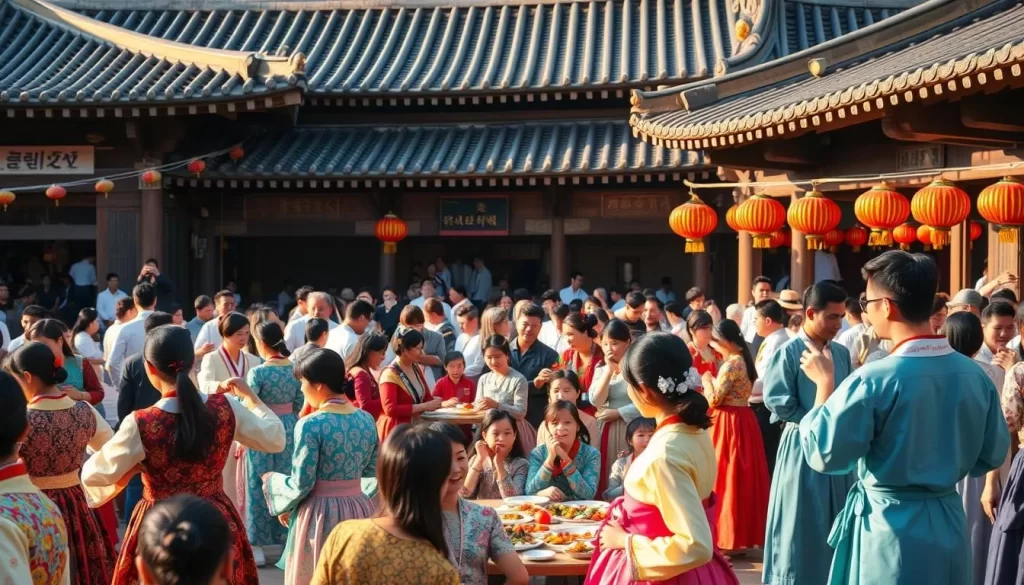
Cultural Significance of Family Reunions
Chuseok, often referred to as Korean Thanksgiving Day, is a time when families come together to honor their ancestors and celebrate the harvest. In 2024, Chuseok falls on September 17, with the holiday period spanning from September 14 to 18, including the weekend. This celebration is marked by ancestral rituals, known as Charye, where families offer food and prayers to their ancestors.
Seollal, the Korean Lunar New Year, is another major holiday that emphasizes family. It’s a day of renewal and reflection, where families gather to perform ancestral rites and share traditional meals. Both Chuseok and Seollal highlight the deep cultural importance of family and the continuity of traditions across generations.
Traditional Games and Festive Foods
These celebrations are also filled with traditional games and delicious foods. During Chuseok, families enjoy songpyeon, a rice cake made with sesame seeds, beans, and chestnuts, steamed with pine needles for a unique aroma. The preparation of songpyeon is believed to bring good fortune, especially in marriage and family life.
Traditional games like ssireum (wrestling) and ganggangsullae (a folk dance) add to the festive atmosphere. Ganggangsullae, performed by women in hanbok, dates back to the Joseon dynasty and is a symbol of unity and joy. These activities not only entertain but also connect participants to their cultural heritage.
Jeon, a type of Korean pancake, is another staple during these celebrations. Made with fish, meat, and vegetables, it pairs perfectly with traditional Korean liquor, making the feast even more special.
Participating in Chuseok and Seollal offers a unique opportunity to experience Korean culture firsthand. These celebrations are a living practice, blending history, family, and gratitude into a vibrant cultural experience. Don’t miss the chance to be part of these unforgettable traditions.
Modern Festivities and Urban Celebrations in Seoul
The city’s modern celebrations redefine how culture is experienced. These events blend contemporary music, digital art, and innovative public displays, creating a vibrant contrast to traditional festivals. Each activity is designed to captivate and inspire, drawing in young audiences and trendsetters alike.
One of the standout events is the Seoul International Fireworks Festival, held annually at the 63 City Building. Recognized as one of the world’s largest firework festivals, it combines pyrotechnics with live music performances, lighting up the sky in early October. This event is a perfect example of how modern festivities energize the city each year.
Contemporary Music and Art Festival Highlights
Music and art take center stage in many urban celebrations. The Lotus Lantern Festival features an open-air lantern exhibition and a parade from Dongdaemun Gate to Jogyesa Temple, blending traditional elements with modern creativity. These innovative lantern displays illuminate the city, creating a mesmerizing visual experience.
Another highlight is the Yeongdeungpo Yeouido Spring Flower Festival, held in the second week of April. This event transforms the streets into a colorful canvas, attracting thousands of visitors with its stunning floral displays. It’s a testament to how modern festivals can merge natural beauty with artistic expression.
These celebrations are more than just events; they’re a reflection of the city’s dynamic spirit. By blending the past with the present, they offer a unique way to experience culture in an urban setting. Whether you’re enjoying a music festival or marveling at a lantern parade, these modern festivities are unforgettable.
A Guide to Busan and Beyond for Festival Lovers
Discover the charm of coastal cities and their vibrant cultural events. While the capital is a hub of activity, venturing beyond offers a chance to explore festivals that celebrate regional diversity and heritage. From cinematic showcases to natural wonders, these events provide a unique glimpse into the heart of the country’s culture.
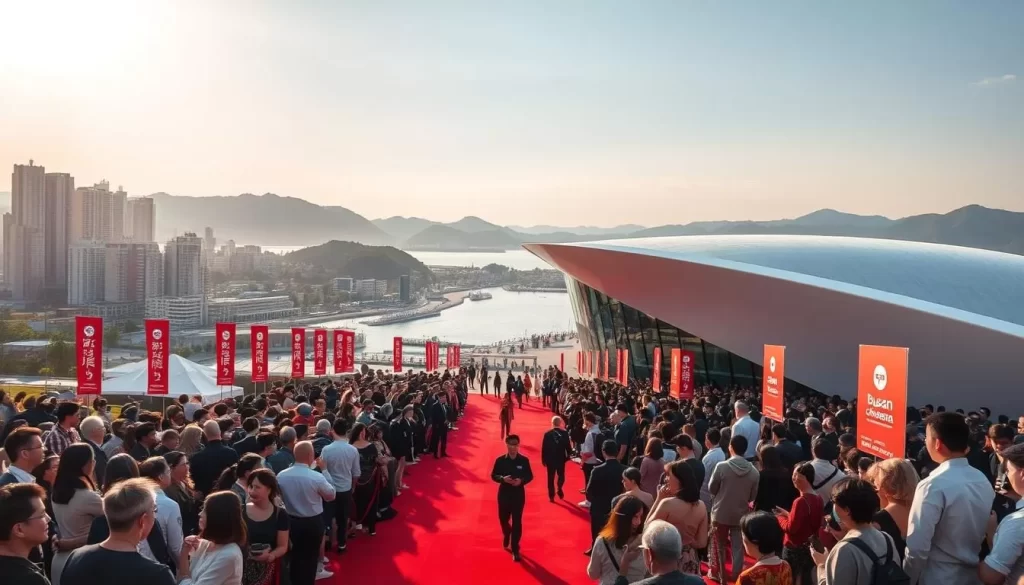
Highlights from the Busan International Film Festival
The Busan International Film Festival is a must-see event for cinema enthusiasts. Established in 1996, it has grown into one of Asia’s most prestigious film festivals, attracting filmmakers and audiences from around the world. Held annually in October, it showcases a diverse range of films, from independent productions to international blockbusters.
This festival is more than just a celebration of cinema; it’s a reflection of Busan’s cultural heritage. Visitors today can enjoy screenings at iconic venues like the Busan Cinema Center, which blends modern architecture with the city’s coastal beauty. The event also features workshops, panel discussions, and opportunities to meet industry professionals.
Beyond the films, the festival highlights the city’s natural charm. Busan’s beaches and mountains provide a stunning backdrop, making it a perfect destination for those who love both art and nature. Whether you’re a film buff or a casual viewer, this event offers an unforgettable experience.
| Festival | Time of Year | Highlights |
|---|---|---|
| Busan International Film Festival | October | Film screenings, workshops, and coastal venues |
| Jinhae Cherry Blossom Festival | March-April | Cherry blossoms and cultural performances |
| Gwangyang Maehwa Plum Blossom Festival | March | Plum blossoms and traditional activities |
Exploring festivals across the country enriches your travel experience. From the cinematic allure of Busan to the natural beauty of Jinhae’s cherry blossoms, each event offers a unique perspective on the region’s history and culture. Don’t miss the chance to discover these hidden gems and create lasting memories.
Syncing Your Travel Plans with South Korea’s Festival Calendar
Planning your trip around the country’s vibrant events can transform your visit into an unforgettable adventure. From cherry blossoms in spring to lantern-lit streets in fall, each season offers unique experiences. To make the most of your journey, it’s essential to align your schedule with the festival calendar and understand local time zones.
Understanding Korea Standard Time
Korea Standard Time (UTC+9) is nine hours ahead of Coordinated Universal Time. If you’re traveling from the U.S., this means adjusting to a significant time difference. For example, when it’s noon in New York, it’s already 2 AM the next day in the country. Plan your arrival and departure times carefully to avoid jet lag and ensure you’re ready to enjoy the festivities.
Strategic Planning for Festival Seasons
Each season brings its own charm and events. Spring is perfect for cherry blossom festivals, while summer is packed with outdoor activities like the Boryeong Mud Festival, featuring mud wrestling and water sports. Autumn highlights include Chuseok, a time for family gatherings and traditional food, and winter offers ice fishing and sledding at the Hwacheon Sancheoneo Ice Festival.
To maximize your fun, check local event dates in advance. Popular festivals like the Jinju Namgang Yudeung Festival, held from October 1 to 8, attract large crowds, so early planning is key. Use apps or websites to stay updated on schedules and make reservations for accommodations and transportation ahead of time.
By syncing your travel plans with the festival calendar, you’ll experience the best of what the country has to offer. Whether it’s strolling through lantern-lit streets or enjoying summer activities, strategic planning ensures a seamless and memorable trip.
Festival Travel Tips for the Savvy Visitor
Exploring festivals is a fantastic way to immerse yourself in local culture, but smart planning can make your experience even better. Whether you’re traveling with family or solo, these tips will help you navigate busy events and make the most of your trip.
Booking Accommodations and Avoiding Crowds
Popular festivals attract large crowds, so booking accommodations early is essential. Look for hotels or guesthouses near the event venue to save time and energy. For a more authentic experience, consider staying in a traditional hanok guesthouse, which offers a unique way to connect with local culture.
To avoid peak crowd times, plan your visit during weekdays or early mornings. Many festivals, like the Busan International Film Festival, offer early bird tickets or special packages for visitors. This strategy ensures a smoother experience and lets you enjoy the event without feeling overwhelmed.
Navigating Local Transportation
Public transportation is a convenient way to get around during festivals. The subway system in major cities is efficient and affordable, with ticket prices up to 2,000 won. Apps like KakaoMap or Naver Map can help you navigate routes and schedules with ease.
For family travel, consider renting a car or using ride-sharing services. This option provides flexibility, especially if you’re traveling with young children or elderly members. Keep in mind that parking can be limited near festival sites, so plan accordingly.
| Tip | Details |
|---|---|
| Book Early | Secure accommodations months in advance for popular festivals. |
| Use Public Transport | Subways and buses are efficient and cost-effective. |
| Plan Off-Peak Visits | Avoid weekends and midday crowds for a better experience. |
Traveling during the ensures mild weather and fewer crowds. Spring and autumn are ideal for festivals, offering pleasant temperatures and vibrant scenery.
By following these tips, you’ll create lasting memories while keeping tradition alive. Whether it’s enjoying a lantern parade or savoring street food, smart planning enhances every aspect of your festival journey.
Culinary Delights at South Korean Festivals
South Korean festivals are a feast for the senses, offering a unique blend of flavors and traditions. From bustling street food stalls to regional specialties, these events are a chance to explore the country’s rich cultural heritage through its cuisine. Whether you’re savoring spicy tteokbokki or indulging in sweet hotteok, every bite tells a story.
Street Food and Regional Specialties
Festival streets come alive with the aroma of sizzling delicacies. Spicy tteokbokki, a chewy rice cake dish, is a crowd favorite, while crispy hotteok, filled with brown sugar and nuts, offers a sweet contrast. Regional specialties like Jeonju bibimbap and Gwangju kimchi showcase the diversity of Korean cuisine, with each dish reflecting local flavors and traditions.
During the cherry blossom season, festivals feature seasonal treats like cherry-infused desserts and salads made with tender spring greens. These dishes not only delight the palate but also celebrate the beauty of nature, making them a must-try for visitors.
Traditional Dishes You Must Try
Festivals are the perfect opportunity to taste traditional dishes that embody Korea’s cultural heritage. Tteokguk, a rice cake soup traditionally eaten on New Year’s Day, symbolizes new beginnings and good luck. Kimchi, a staple in Korean cuisine, is celebrated at events like the Gwangju World Kimchi Festival, where visitors can join kimchi-making workshops.
For a deeper dive into Korea’s culinary traditions, consider exploring the culinary delights of South Korea. This journey offers a comprehensive experience, blending food with cultural immersion.
From street food to traditional dishes, festivals are an attraction for food lovers. They provide a chance to taste freshly prepared meals while learning about the history and significance behind each dish. Don’t miss the opportunity to explore the culinary side of these vibrant celebrations.
Immerse Yourself in Cultural Heritage and History
Dive into the heart of cultural celebrations that tell stories of heritage and history. Every festival carries a unique narrative, offering a glimpse into the traditions and values that shaped them. These events are more than just entertainment; they are windows into the soul of a culture.
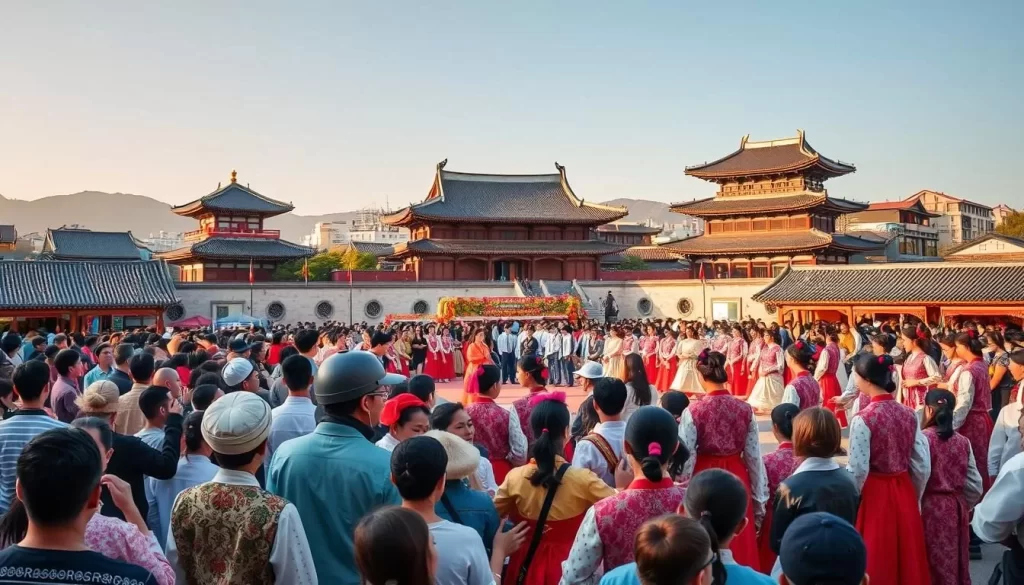
Stories Behind Each Celebration
Each festival is a chapter in a larger story. For example, the K-Royal Culture Festival, held from October 9 to 13, 2024, celebrates its 10th anniversary as the largest cultural heritage festival in the region. This event reenacts royal traditions, such as the “Walking of Royal Family” and the Hanbok Royal Banquet, bringing history to life.
Another example is the Seoul Lantern Festival, where thousands of lanterns illuminate the city, symbolizing hope and cultural heritage. This festival blends ancient traditions with modern artistry, offering a communal experience that highlights folklore and history.
These stories capture the eye of history lovers and cultural enthusiasts alike. Understanding the background of each celebration adds depth to your experience, making it more meaningful and memorable.
Why These Narratives Matter
Learning about the historical and cultural layers behind festivals enhances your appreciation. For instance, the Palace Concert: Ballet x Sujecheon has increased its audience capacity to 650 people per session, reflecting growing interest in traditional performances.
Festivals like these are perfect for history lovers. They provide a glimpse into the past while celebrating the present. Whether it’s through reenactments or traditional music, these events connect you to a rich cultural tapestry.
| Festival | Date | Cultural Highlight |
|---|---|---|
| K-Royal Culture Festival | October 9-13, 2024 | Royal reenactments and Hanbok Banquet |
| Seoul Lantern Festival | Mid-December to late January | Thousands of illuminated lanterns |
| Palace Concert: Ballet x Sujecheon | October 2024 | Traditional music and dance performances |
By exploring these narratives, you’ll gain a deeper understanding of the cultural significance behind each festival. This knowledge transforms your experience, making it richer and more immersive. Don’t miss the chance to dive into the stories that make these celebrations unforgettable.
Outdoor Activities and Family-Friendly Festivities
Festivals aren’t just about watching—they’re about doing. Across the country, celebrations offer a mix of adventure sports, nature walks, and interactive games that bring families together. Whether you’re seeking adrenaline or relaxation, there’s something for everyone.
Adventure Sports at Festival Sites
For thrill-seekers, festivals like the Hwacheon Sancheoneo Ice Festival offer ice fishing and sledding, attracting over 1 million visitors annually. If you’re visiting in spring, the Jinhae Cherry Blossom Festival is a perfect spot for scenic hikes amidst blooming trees. These activities combine natural beauty with excitement, making them unforgettable experiences.
Fun Activities for All Ages
Families can enjoy a variety of interactive games and workshops. The Boryeong Mud Festival, held from July 25 to August 10, features mud wrestling and water sports, perfect for kids and adults alike. For a more relaxed vibe, the Taean Tulip Festival offers stunning floral displays and photo opportunities.
Looking for a family-friendly itinerary? Check this guide for a 13-day tour that includes outdoor adventures and cultural experiences. From hiking to cooking classes, it’s designed to create lasting memories.
- Explore scenic spots like Ganghwa Island’s luge ride during cherry blossom season.
- Join traditional games and workshops at the Gwangju World Kimchi Festival.
- Capture the beauty of nature at the Jeju Fire Festival, celebrated over three days in March.
These festivities are more than just events—they’re opportunities to connect with nature, culture, and each other. Whether you’re climbing ice walls or strolling through tulip fields, every moment is a celebration of life and beauty.
Sustainability and the Future of South Korean Festivals
Sustainability is taking centre stage in the vibrant world of cultural celebrations. As festivals grow in popularity, organizers are increasingly focusing on eco-friendly practices to ensure these events remain enjoyable for future generations. This shift towards sustainability is not just a trend; it’s a necessary thing to protect the environment while preserving cultural heritage.
Eco-Friendly Initiatives in Festival Planning
Festival organizers are incorporating innovative practices to reduce waste and promote recycling. For example, many events now use biodegradable materials for dining options, aligning with eco-friendly principles. This approach not only minimizes environmental impact but also sets a standard for other events to follow.
During winter festivals, sustainability efforts are particularly visible. The Hwacheon Sancheoneo Ice Festival, for instance, emphasizes eco-conscious activities like ice fishing and sledding, attracting over 1 million visitors annually. These initiatives show how festivals can balance fun with environmental responsibility.
Another fact worth noting is the use of locally sourced and organic ingredients in festival food. This practice reduces the carbon footprint and supports local farmers. By prioritizing sustainability, festivals are becoming a model for eco-friendly tourism.
These efforts are a clear indication that sustainability is now a centrepiece of festival planning. From waste reduction to energy-efficient lighting, every thing is being reimagined to create a greener future. Visitors are encouraged to support these initiatives by choosing events that prioritize conservation.
To learn more about upcoming eco-friendly festivals, check out this . It highlights events that blend cultural richness with sustainable practices, offering a unique experience for all attendees.
Local Hidden Gems: Off the Beaten Path Festival Spots
Beyond the well-known events, there are hidden celebrations that offer a deeper connection to the nation’s culture. These lesser-known festivals provide an intimate glimpse into traditions that are often overlooked by mainstream tourist guides. If you’re looking for a unique experience, these off-the-beaten-path spots are worth exploring.
Discovering Neighborhood Celebrations
In smaller cities and neighborhoods, festivals are often more personal and community-driven. For example, the Jeonju Bibimbap Festival celebrates the city’s iconic dish with cooking contests, tastings, and cultural performances. This event is a perfect way to immerse yourself in local traditions while enjoying delicious food.
Another hidden gem is the Boseong Green Tea Festival, held in May. Set against the backdrop of lush green tea fields, this festival offers tea tastings, traditional music, and hands-on workshops. It’s a serene escape from the hustle and bustle of larger events.
Unique Cultural Hideaways
For a truly unique experience, visit the Jindo Sea Parting Festival. This natural phenomenon occurs annually, creating a path between Jindo and Modo Island. The event includes folk performances, traditional rituals, and local cuisine. It’s a rare opportunity to witness a blend of nature and culture.
If you’re exploring Jeju Island, don’t miss the Jeju Fire Festival. Held in March, this event features torchlight parades, bonfires, and traditional games. It’s a celebration of the island’s volcanic heritage and a must-see for history enthusiasts.
To discover more hidden gems, check out this guide for unique spots that are often overlooked by tourists. These festivals and celebrations offer a chance to connect with the nation’s culture in a more personal and meaningful way.
| Festival | Location | Highlights |
|---|---|---|
| Jeonju Bibimbap Festival | Jeonju | Cooking contests, tastings, cultural performances |
| Boseong Green Tea Festival | Boseong | Tea tastings, traditional music, workshops |
| Jindo Sea Parting Festival | Jindo | Folk performances, traditional rituals, local cuisine |
| Jeju Fire Festival | Jeju Island | Torchlight parades, bonfires, traditional games |
Exploring these hidden gems allows you to experience the nation’s cultural diversity beyond the usual tourist spots. Whether it’s a cooking contest or a natural phenomenon, these festivals offer unforgettable memories and a deeper connection to the local way of life.
Conclusion
From vibrant lantern displays to cultural reenactments, these events offer a journey through time and tradition. Each location brings its own unique charm, blending history, modern culture, and culinary delights into unforgettable experiences. Whether you’re exploring a bustling site or a hidden gem, every festival tells a story that connects the past with the present.
As a visitor, you’ll find yourself immersed in a world of outdoor adventures, traditional games, and mouthwatering street food. These celebrations are more than just events—they’re a way to experience the heart of a culture. From the Jinju Lantern Festival, which dates back to 1592, to the vibrant Andong Mask Festival, each site offers something special.
Ready to create lasting memories? Start planning your journey to explore these incredible locations. Dive into the rich tapestry of Korean cultural heritage and discover why these festivals are a must-see for every visitor.
The above is subject to change.
Check back often to TRAVEL.COM for the latest travel tips and deals.
